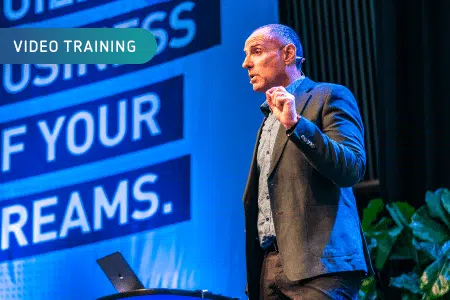In this article, I want to explain six steps to implement Profit First. People talk a lot about this as a way to not just grow their business but keep it secure financially, but it does take a while to get this system up and running.
Often, business owners remark that Profit First doesn’t work for them. It’s usually because they haven’t taken the right approach. So let’s dive into things:
A step by step approach to Profit First
#1 Analyse your business expenses
The first step is to understand exactly what you’re spending your money on, based on the GST exclusive amount of income into your bank account—the cash that actually comes in. Your Xero or MYOB system should let you look at this amount, or you can ask your bookkeeper.
Then, for every hundred dollars that comes in, you need to understand what percentage is going to things like:
- Owners compensation (the money you pay yourself)
- Tax
- Employee expenses
- Loan repayments
- Vehicle costs
- Subscriptions
- Materials and subcontractors etc.,
It can be confusing, so remember to look at the total amount of money that comes in. For example, if you’re a travel agent and a client pays you $10k for a cruise, but you hand over $9k to the cruise company, that will be included as a ‘materials and subcontractors’ cost. From the remaining $1k, break down what money goes where, e.g. to subscriptions, office expenses, operating expenses etc.
You don’t have to go into details like what’s going into trusts or the tax you pay on your owners compensation etc. It’s all about how much cash is leaving your business bank account each month in order to pay you, pay company tax or run the business. A Profit First expert can help you with this if you have a complicated structure.
At the end of this exercise, you should have an idea of how much cash profit you’re generating.
Often, the amount is $0. When you realise this, you’ll experience a bit of a ‘come to Jesus’ moment. That’s ok… we are just getting started.
#2 Build your roadmap
Now it’s time to build a roadmap that helps you move closer towards your industry profit benchmarks or your personal profit goals.
You’ll set a target, perhaps 10 percent profits or thereabouts, by the end of a 12—or 24-month period, gradually allocating larger percentages from your current position.
Create a timeline to work towards… remember, slow is smooth and smooth is fast. It’s ok to start off small but do things right the first time.
The reason to do things slowly is that you’ll probably run out of cash if you try to jump from 0 to 10 per cent profits in one month.
#3 Allocate your balance
Now establish bank accounts where your money can go. Have an account that tax comes out of, one for staff salary etc. This won’t cost you any more for your bookkeeping but it makes it a lot easier to allocate funds to the right places and know how much should go where.
One of these accounts should be a ‘profit hold’ account, where you send profits automatically each month. Try to automate this and avoid micromanaging it or checking it constantly. Even use a separate bank if you have to.
Every business is different so you can send funds to your different accounts weekly, fortnightly or monthly etc. I do income allocations and profit distribution every Monday morning and it usually only takes a few minutes.
The idea is that each account will get the right amount of money and if something is out of balance it will be easier to see what’s going on.
#4 Follow tempo, test and adjust
You should start getting used to the process and a tempo for your Profit First approach but you will have to get used to checking regularly, testing and adjusting.
You might find you’ve gone a bit too hard on your profit allocation and you can’t pay your bills. In this case, check if you can reduce expenses before you reduce profits.
#5 Quarterly allocations
Now it’s time to decide what to do with your Profits. The book says, and I recommend the same, that you should distribute 50% of your profits to yourself for something fun. If you have done well and saved $1000 over the quarter, spend $500 on a night out.
If you’re confident that you have accounted for the tax you will pay on your profits, you can also spend the rest on something to help build the business, or in another way you choose. Or you can allow it to continue to build, with a larger goal in mind.
#6 Reset your tap
Every time you increase your profit, unless your business is making a lot more money, it’s likely you will have to reduce something else. But often, when you really look, there are things that can go. You may be able to renegotiate with suppliers, update your loan arrangement or cut unnecessary costs. It isn’t always easy but it will be worth it to increase your profits and your owner’s compensation, which are the reasons you are in business after all.
Now you should be on your way to growing a truly profitable business and an asset you can potentially sell or hand to the next generation.
Keep this in mind
‘Parkinson’s Law’ explains that what you have will fill the space.
For example, if you have two weeks to complete a homework assignment that will take two days, you will put it off until the last two days. If you have a huge plate of food you will eat it, but if you have a smaller plate with less food, it’s unlikely that you will end up feeling hungry.
This applies to household finances as well; often you hear people with very healthy incomes saying they are struggling financially. This is because they have allocated all of their money to expenses like the mortgage, cleaner, pool guy etc.
Profit First leverages Parkinson’s Law but reminds you to put Profit First. Even if it is only $200 per month to start with, make this a non-negotiable part of your financial management. This way, the rest of your expenses can take up the ‘space’ you have left for them.
It’s not a perfect world and unexpected expenses do crop up but if you make profit a priority rather than an afterthought, you will get closer to your dream business and sustainable finances.













